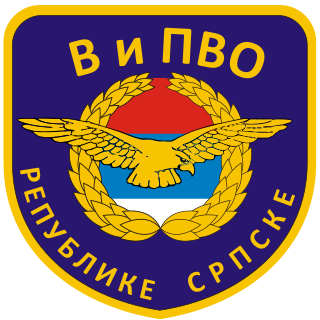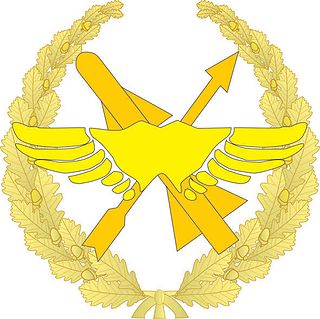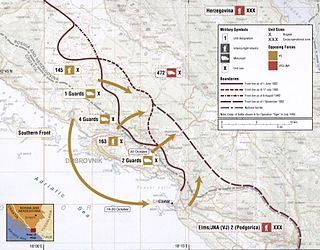
The Armed Forces of Bosnia and Herzegovina is the official military force of Bosnia and Herzegovina. The BiH armed forces were officially unified in 2005 and are composed of two founding armies: the Bosniak Army of the Federation of Bosnia and Herzegovina (VFBiH) and the Bosnian Serbs' Army of Republika Srpska (VRS).
The Army of Republika Srpska, commonly referred to in English as the Bosnian Serb Army, was the military of Republika Srpska, the self-proclaimed Serb secessionist republic, a territory within the newly independent Bosnia and Herzegovina, which it defied and fought against. Active during the Bosnian War from 1992 to 1995, it continued to exist as the armed forces of RS, one of two entities making up Bosnia and Herzegovina, until 2006 when it was integrated into the Armed Forces of Bosnia and Herzegovina. Forces of the VRS engaged in several campaigns, including Operation Corridor 92, Operation Vrbas '92, Operation Bura, and Operation Spider; they were also involved in the siege of Sarajevo, as well as the Srebrenica massacre.

The Yugoslav People's Army, also called the Yugoslav National Army, was the military of the Socialist Federal Republic of Yugoslavia and its antecedents from 1945 to 1992.

The Army of the Republic of Bosnia and Herzegovina, often referred to as Bosnian Army or Bosniak Army, was the military force of the Republic of Bosnia and Herzegovina. It was established by the government of the Republic of Bosnia and Herzegovina in 1992 following the outbreak of the Bosnian War.

The Republika Srpska Air Force was the air force of Republika Srpska and was used primarily during the Bosnian war. In 2005, it was integrated into the Armed Forces of Bosnia and Herzegovina. SFOR still plays a large role in Bosnia and Herzegovina, which consists of the Federation of Bosnia and Herzegovina and Republika Srpska. Under the leadership of one president, the ministry of defense of both entities merged into one single ministry of defense with one chief of joint staff commanding both Air Forces. In 2004 there was again a restructuring of the armed forces, bringing the number of Air Force personnel down to 4,000. Next to the command, the 1st Regiment V i PVO consists out of a platoon, a radar battalion, artillery rocket ADF battalion, AF logistics battalion and aviation assets, a Fighter Bomber Squadron and Mixed Helicopter Squadron. In 2006 the Air Force of Republika Srpska was disbanded.

The Croatian Defence Council was the official military formation of the Croatian Republic of Herzeg-Bosnia, an unrecognized state that existed in the Republic of Bosnia and Herzegovina between 1991 and 1996. The HVO was the main military force of the Croats of Bosnia and Herzegovina.
Operation Sana was the final military offensive of the Army of the Republic of Bosnia and Herzegovina in western Bosnia and Herzegovina and the last major battle of the Bosnian War. It was launched from the area of Bihać on 13 September 1995, against the Army of Republika Srpska, and involved advances towards Bosanski Petrovac, Sanski Most and Bosanska Krupa. At the same time, the Croatian Army and the Croatian Defence Council were engaging the VRS in Operation Maestral 2 further to the southeast. After an initial 70-kilometre (43 mi) advance, VRS reinforcements managed to stop the ARBiH short of Sanski Most and Novi Grad, and reversed some of the ARBiH's territorial gains in a counterattack. After a part of the ARBiH 5th Corps was threatened with defeat around the town of Ključ, the ARBiH requested assistance from the HV.
Operation Mistral 2, officially codenamed Operation Maestral 2, was a Croatian Army (HV) and Croatian Defence Council (HVO) offensive in western Bosnia and Herzegovina on 8–15 September 1995 as part of the Bosnian War. Its objective was to create a security buffer between Croatia and positions held by the Bosnian Serb Army of Republika Srpska (VRS). The operation also spearheaded a Herzeg-Croat led move to compromise the occupation of the largest Bosnian Serb-held city, Banja Luka, by capturing the towns of Jajce, Šipovo and Drvar. Thus jeopardizing the operations capacity of Banja Luka and ultimately leading to its recapture. The combined HV and HVO forces were under the overall command of HV Major General Ante Gotovina.

The Patriotic League was the first paramilitary unit of Territorial Defence Force of the Republic of Bosnia and Herzegovina (TORBiH).

Rasim Delić was the chief of staff of the Bosnian Army. He was a career officer in the Yugoslav Army but left it during the breakup of Yugoslavia and was convicted of war crimes by the International Criminal Tribunal for the former Yugoslavia for failing to prevent and punish crimes committed by the El Mujahid unit under his command. He was sentenced to 3 years in prison.

This section is about the history of the Army of the Republic of Bosnia and Herzegovina that existed from 1992 to 1995, then it was formed into two armies of the two entities from 1998 to 2005 and finally transformed into the Armed Forces of Bosnia and Herzegovina (OSBIH).
Enver Hadžihasanović is a former Bosnian chief of staff of the Army of the Republic of Bosnia and Herzegovina and a convicted war criminal.
The 1992 Yugoslav People's Army column incident in Tuzla, also known as Tuzla column was an attack on the 92nd Motorized Brigade of the Yugoslav People's Army (JNA) in the Bosnian city of Tuzla on 15 May 1992. The incident occurred at the road junction of Brčanska Malta. At least 54 soldiers of the JNA were killed and 44 wounded during the attacks. What started off as a peaceful retreat by agreement with local authorities ended in an ambush, when Patriotic League, Green Berets and Bosniaks from local police attacked the column. It was a repeat of a similar incident that occurred in Sarajevo a week prior.

The Supreme Command of the Army of the Republic of Bosnia and Herzegovina was the supreme command of the Army of the Republic of Bosnia and Herzegovina and it was headquartered in the Presidency Building in Sarajevo.

The Air Force and Air Defence Brigade of Bosnia and Herzegovina is part of the Armed Forces of Bosnia and Herzegovina. The headquarters is in Sarajevo. It maintains operating bases at Sarajevo International Airport, Banja Luka International Airport and Tuzla International Airport.

The Battle of Kupres was a battle of the Bosnian War, fought between the Army of the Republic of Bosnia and Herzegovina (ARBiH) and the Croatian Defence Council (HVO) on one side and the Army of Republika Srpska (VRS) on the other from 20 October to 3 November 1994. It marks the first tangible evidence of the Bosniak–Croat alliance set out in the Washington Agreement of March 1994, brokered by the United States to end the Croat–Bosniak War fought between the ARBiH and the HVO in Bosnia and Herzegovina. The ARBiH and the HVO were not coordinated at first, rather they launched separate operations aimed at capture of Kupres.

Operation Tiger was a Croatian Army (HV) offensive conducted in areas of Croatia and Bosnia and Herzegovina near Dubrovnik between 1 and 13 July 1992. It was designed to push the Army of Republika Srpska (VRS) away from the city towards Popovo field and secure a supply route via Rijeka Dubrovačka, which was gained in early June as the siege of Dubrovnik by the Yugoslav People's Army (JNA) was lifted. The operation's success was facilitated by the establishment of the HV's Southern Front command and the successful conclusion of the May–June 1992 operations against the VRS in the Neretva River valley, which concluded with Operation Jackal.
The Agreement on Friendship and Cooperation between Bosnia and Herzegovina and Croatia was signed by Alija Izetbegović, President of the Republic of Bosnia and Herzegovina, and Franjo Tuđman, President of the Republic of Croatia, in Zagreb on 21 July 1992 during the Bosnian and Croatian wars for independence from Yugoslavia. It established cooperation, albeit inharmonious, between the two and served as a basis for joint defense against Serb forces. It also placed the Croatian Defence Council (HVO) under the command of the Army of the Republic of Bosnia and Herzegovina (ARBiH).
The Battle of Kupres was a battle of the Bosnian War, fought between the Bosnian Croat Territorial Defence Force supported by the Croatian Army troops on one side and the Yugoslav People's Army, augmented by the Bosnian Serb TO on the other at the Kupres Plateau, on 3–11 April 1992. During the fighting on 8 April, the Bosnian Croat TO was reorganised as the Croatian Defence Council. The objective of the battle was to control the strategic Kupres Plateau, a major supply route.
Operation Southern Move was the final Croatian Army (HV) and Croatian Defence Council (HVO) offensive of the Bosnian War. It took place in western Bosnia and Herzegovina on 8–11 October 1995. Its goal was to help the Army of the Republic of Bosnia and Herzegovina (ARBiH) whose positions around the town of Ključ, captured by them during Operation Sana, were endangered by a counteroffensive by the Army of Republika Srpska (VRS). The objectives of Operation Southern Move included the capture of the town of Mrkonjić Grad and positions on the Manjača Mountain which would allow the HV and the HVO to directly threaten Banja Luka, the largest city controlled by Bosnian Serbs. Finally, the offensive was also aimed at capturing the Bočac Hydroelectric Power Station, the last significant source of electricity under VRS control in western Bosnia and Herzegovina. The combined HV and HVO forces were under the overall command of HV Major General Ante Gotovina.












